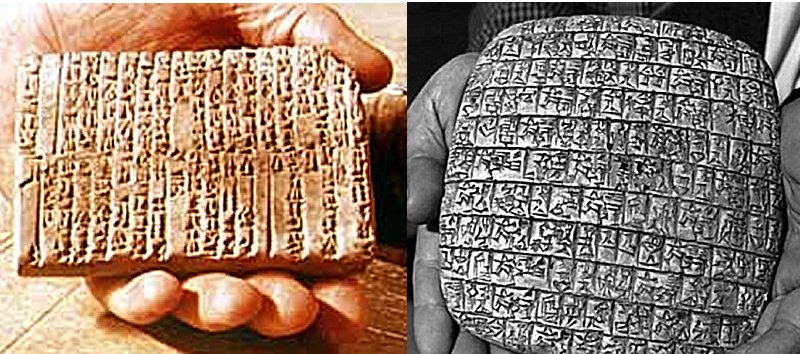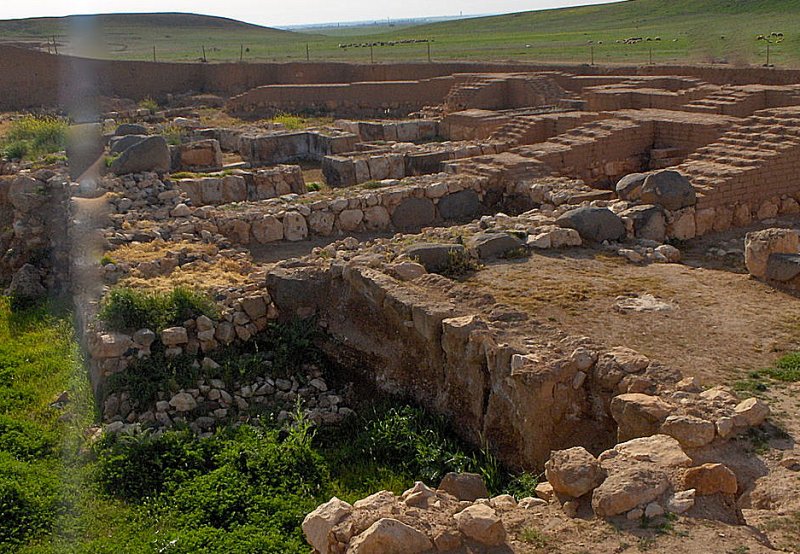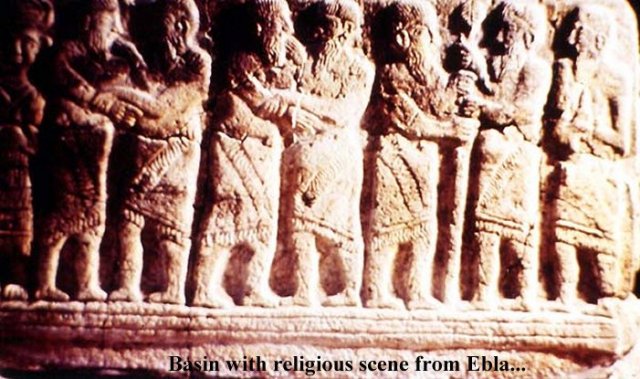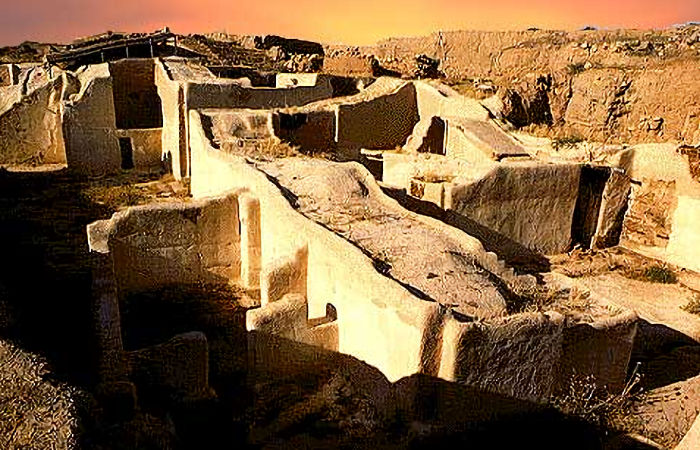Mysterious Ancient City Of Ebla That Existed Thousand Years Before Biblical Kings David And Solomon
A. Sutherland - AncientPages.com - The mysterious ancient city of Ebla ("White Rock") existed a thousand years before the biblical time of Kings David and Solomon. The Assyrians, led by Sargon of Akkad's grandson Naram-Sin (ca. 2240 BC), destroyed Ebla by putting it to the torch.
The fire destroyed the city and then followed 250 years of impoverishment, after which the Amorites, who dominated Mesopotamia, Palestine, and Syria during the period from about 2000 to 1600 BC., sacked Ebla and established their own dynasty.
Ancient Ebla tablets. Credit: Wikimedia Commons
The Amorites rebuilt the palace and a temple, and a statue representing one of their kings but only limited prosperity returned to the city, which slowly renewed relations with Egypt, which is based on a decorated bone scepter of the Egyptian king Ḥtp-ib-Re (reigned c. 1750 BC) unearthed at the site of excavated Ebla.
Until today, no one would have known about Ebla if it hadn’t been for an out of sight, almost missed notice in the ancient record made in Assyrian and Akkadian records concerning its fall.
The vizier palace - in the ancient city of Ebla. Image credit: Mappo - CC BY-SA 4.0
Inspired by this historical notice, a team of archaeologists led by Dr. Paolo Matthiae, professor of Near East Archaeology at the University of Rome began to excavate Tell Mardikh and a neighboring mound ('tell', in Arabic and 'tel', in Hebrew), located about 33 miles (55 km) southwest of Aleppo, in northwestern Syria.
In 1969, it was the first time the ancient Ebla was recognized, and excavations that uncovered a remarkable royal archive revealed Ebla's importance.
First occupied in 4,000 BC, it had its period of power and wealth in the mid-3,000 BC. It maintained trade relations with Mesopotamia, Egypt, Sumer, and Iran, especially with the ancient city of Kish (the Bible calls Kush).
Ebla had about 250,000 inhabitants - skilled craftsmen in metals, textiles, ceramics, and woodwork - and was administered by a large bureaucracy, according to the ancient royal archive unearthed in 1975 and consisting of 15,000 clay tablets inscribed in cuneiform script and some written in a previously unknown language - now termed Eblaite.
The tablets were found carefully stacked on wooden shelves, which unfortunately had collapsed due to the palace's destruction.
Ebla, which was destroyed by fire and rebuilt several times, existed until about 1600 BC. The evidence indicates yet another destruction by fire, but the place was abandoned this time. Ebla has remained totally deserted except for a small group of monks who lived there temporarily during the Roman or Byzantine time.
Many deciphered tablets inform that the kingdom had trade relations with Megiddo, Byblos, Sidon, Akko, Gaza, Jerusalem, and the Biblical Hazor, the largest biblical-era site in Israel, known as "the head of all those kingdoms".
"Tablet 1860 names the five cities of Genesis 14:2 in the same order, i.e., Sodom, Gomorrah, Admah, Zeboiim and Zoar..." and predates the great catastrophe involving the Prophet Lot and the areas of Sodom and Gomorrah which were destroyed."
"...And Joshua at that time turned back, and took Hazor, and smote the king thereof with the sword: for Hazor beforetime was the head of all those kingdoms..." (Joshua 11:10). Ruins of the royal palace, in Ebla, Syria. Credit: Wikimedia Commons - CC BY-SA 3.0
On the tablets of Ebla are included:
'very early Canaanite creation and flood stories which very closely resemble that of the Bible..." (D. Rohl, "A Test of Time") and the names of prophets known from the holy scriptures like Ab-ra-mu (Abraham), E-sa-um (Esau), Ish-ma-ilu (Ishmael), even Is-ra-ilu (Israel), and those from later periods, like Da-'u'dum (David) and Sa-'u-lum (Saul). Other texts describe Ebrum, the third and greatest of the six kings of the Ebla dynasty between 2400 and 2250 BC.'
Ebrum was placed on the mighty throne of Ebla by Sargon the Great of Akkad or "Righteous Ruler", who was a close associate of the Sumerian goddess Inanna (Ishtar) known as the "Lady of the battlefield."
Updated on May 13, 2022
Written by A. Sutherland - AncientPages.com Staff Writer
Copyright © AncientPages.com All rights reserved. This material may not be published, broadcast, rewritten or redistributed in whole or part without the express written permission of AncientPages.com
More From Ancient Pages
-
 Native American Population Does Not Originate In Japan – Genetics And Skeletal Biology Questioned
Archaeology | Nov 15, 2021
Native American Population Does Not Originate In Japan – Genetics And Skeletal Biology Questioned
Archaeology | Nov 15, 2021 -
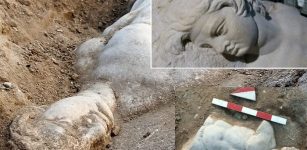 1,800-Year-Old Relief Of Mythological Satyr Figure Under Restoration
Artifacts | Sep 5, 2020
1,800-Year-Old Relief Of Mythological Satyr Figure Under Restoration
Artifacts | Sep 5, 2020 -
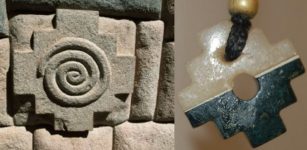 Mysterious Chakana – Sacred Inca Cross And Its Connection To The Southern Cross Constellation
Ancient Symbols | Sep 15, 2018
Mysterious Chakana – Sacred Inca Cross And Its Connection To The Southern Cross Constellation
Ancient Symbols | Sep 15, 2018 -
 Young Boy Discovers Rare Ancient Roman Treasure In Sussex, UK
Archaeology | Apr 15, 2024
Young Boy Discovers Rare Ancient Roman Treasure In Sussex, UK
Archaeology | Apr 15, 2024 -
 Why The Discovery Of Cleopatra’s Tomb Would Rewrite History
Featured Stories | Nov 16, 2022
Why The Discovery Of Cleopatra’s Tomb Would Rewrite History
Featured Stories | Nov 16, 2022 -
 Pryor Mountains Are Home To The Mysterious Little People – Native Americans Say
Featured Stories | Aug 2, 2021
Pryor Mountains Are Home To The Mysterious Little People – Native Americans Say
Featured Stories | Aug 2, 2021 -
 Ancient DNA Reveals The Earliest Evidence Of The Last Massive Human Migration To Western Europe
DNA | Jul 24, 2023
Ancient DNA Reveals The Earliest Evidence Of The Last Massive Human Migration To Western Europe
DNA | Jul 24, 2023 -
 Ancient Manuscripts About Sea Monsters Solve An Ocean Mystery
News | Mar 1, 2023
Ancient Manuscripts About Sea Monsters Solve An Ocean Mystery
News | Mar 1, 2023 -
 Strange Ancient And Medieval Encounters With Unusual Beings Reported And Documented
Featured Stories | Jan 15, 2024
Strange Ancient And Medieval Encounters With Unusual Beings Reported And Documented
Featured Stories | Jan 15, 2024 -
 Jesus Christ’s Tomb Dates To Roman Emperor Constantine’s Era – Researchers Confirm
Archaeology | Dec 12, 2017
Jesus Christ’s Tomb Dates To Roman Emperor Constantine’s Era – Researchers Confirm
Archaeology | Dec 12, 2017 -
 Remarkable South-Pointing Chariot – Ancient Cybernetic Machine Invented 1,700 Years Ago Is An Engineering Masterpiece
Ancient Technology | Jul 17, 2014
Remarkable South-Pointing Chariot – Ancient Cybernetic Machine Invented 1,700 Years Ago Is An Engineering Masterpiece
Ancient Technology | Jul 17, 2014 -
 Nail Polish Was Used In 3,000 B.C. – Color Of Fingernails Indicated Social Status In Ancient China And Egypt
Ancient History Facts | Jan 11, 2018
Nail Polish Was Used In 3,000 B.C. – Color Of Fingernails Indicated Social Status In Ancient China And Egypt
Ancient History Facts | Jan 11, 2018 -
 Advanced Ancient Technology: Could Ancient Peruvians Soften Stone?
Ancient Technology | May 7, 2015
Advanced Ancient Technology: Could Ancient Peruvians Soften Stone?
Ancient Technology | May 7, 2015 -
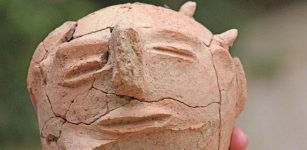 A Head Of A Statue Dated To 700 BC, Animal Figurines And Jordan Valley’s Occupation History
Archaeology | Sep 1, 2018
A Head Of A Statue Dated To 700 BC, Animal Figurines And Jordan Valley’s Occupation History
Archaeology | Sep 1, 2018 -
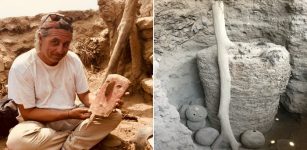 A 1,000-Year-Old Intact Mummy Unearthed In Ancient Pachacamac Site, Peru
Archaeology | May 31, 2018
A 1,000-Year-Old Intact Mummy Unearthed In Ancient Pachacamac Site, Peru
Archaeology | May 31, 2018 -
 Why Did Ancient Egyptian Scribes Face Serious Health Risks?
Archaeology | Jun 27, 2024
Why Did Ancient Egyptian Scribes Face Serious Health Risks?
Archaeology | Jun 27, 2024 -
 Early European Farmers Traced To Anatolia, DNA Study Shows
Archaeology | Jan 5, 2016
Early European Farmers Traced To Anatolia, DNA Study Shows
Archaeology | Jan 5, 2016 -
 New Unique Ancient Underwater Finds In The Ports Of Caesarea And Acre
Archaeology | Aug 11, 2021
New Unique Ancient Underwater Finds In The Ports Of Caesarea And Acre
Archaeology | Aug 11, 2021 -
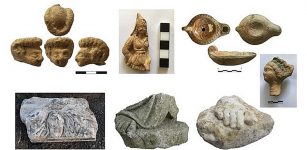 Excavations Of Ancient Theater In 2,400-Year-Old City Of Smyrna, Turkey
Archaeology | Feb 13, 2019
Excavations Of Ancient Theater In 2,400-Year-Old City Of Smyrna, Turkey
Archaeology | Feb 13, 2019 -
 Denisovan Family Tree: New Branches Revealed In Ancient DNA
Archaeology | Apr 12, 2019
Denisovan Family Tree: New Branches Revealed In Ancient DNA
Archaeology | Apr 12, 2019

